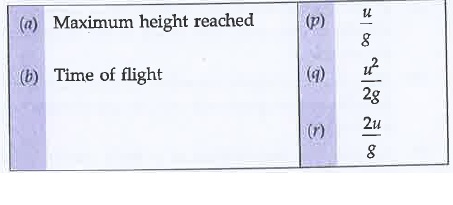A stone is thrown vertically upwards with an initial velocity u from the top of a tower of lieight 12u2g With what velocity does the stone reach the ground?
u
4u
5u
2√6u
The correct Answer is:C
To solve the problem, we need to determine the final velocity of a stone thrown vertically upwards from the top of a tower when it reaches the ground. The height of the tower is given as h=12u2g, where u is the initial velocity of the stone and g is the acceleration due to gravity.
1. Identify the initial conditions:
- The initial velocity of the stone, u.
- The height of the tower, h=12u2g.
- The acceleration due to gravity, g.
2. Determine the maximum height reached by the stone:
When the stone is thrown upwards, it will first ascend until it reaches its maximum height. The maximum height H can be calculated using the formula:
H=u22g
However, since the stone is thrown from a height h, the total height from the ground to the maximum point is:
Htotal=h+H=12u2g+u22g=12u2+0.5u2g=12.5u2g
3. Use the kinematic equation to find the final velocity:
We can use the third equation of motion, which relates initial velocity, final velocity, acceleration, and displacement:
v2=u2+2gh
Here, v is the final velocity when the stone reaches the ground, u is the initial velocity (upwards), and h is the total height from which the stone falls back to the ground.
Substituting the values:
v2=u2+2g(12u2g)
Simplifying this gives:
v2=u2+24u2=25u2
4. Calculate the final velocity:
Taking the square root of both sides:
v=√25u2=5u
Final Answer:
The velocity with which the stone reaches the ground is v=5u.
---
- The initial velocity of the stone, u.
- The height of the tower, h=12u2g.
- The acceleration due to gravity, g.
When the stone is thrown upwards, it will first ascend until it reaches its maximum height. The maximum height H can be calculated using the formula:
H=u22g
However, since the stone is thrown from a height h, the total height from the ground to the maximum point is:
Htotal=h+H=12u2g+u22g=12u2+0.5u2g=12.5u2g
We can use the third equation of motion, which relates initial velocity, final velocity, acceleration, and displacement:
v2=u2+2gh
Here, v is the final velocity when the stone reaches the ground, u is the initial velocity (upwards), and h is the total height from which the stone falls back to the ground.
v2=u2+2g(12u2g)
Simplifying this gives:
v2=u2+24u2=25u2
Taking the square root of both sides:
v=√25u2=5u
The velocity with which the stone reaches the ground is v=5u.
Topper's Solved these Questions
Similar Questions
Knowledge Check
A ball is thrown vertically upward with a velocity u from the top of a tower. If it strikes the ground with velocity 3u, the time taken by the ball to reach the ground is
AugB2ugC3ugD4ugA stone is thrown vertically upwards with an initial speed u from the top of a tower, reaches the ground with a speed 3u. The height of the tower is :
A3u2gB4u2gC6u2gD9u2gQuestion Stimulus
A stone is thrown vertically upwards with an initial velocity of 30ms−1. Acceleration due to gravity g=10ms−2. The maximum height reached by the stone isA30 mB4.5 mC45 mD90 m
A stone is thrown vertically upwards with a velocity of 4.9ms−1. Calculate : the maximum height reached.
View SolutionA stone projected vertically up with velocity v from the top of a tower reaches the ground with velocity 2 v The height of the tower
View Solution[" A ball is thrown vertically downward "],[" with velocity u from the top of a tower."],[" It strikes the ground with a velocity "3u" ."],[" The time taken by the ball to reach the "],[" ground is given by "]
View SolutionA stone is thrown verticaly upward with an initial velocity of 40m/s. Taking g=10m/s2, find the maximum height reached by the stone. What is the net displacement and the total distance covered by the stone?
View SolutionA particle is thrown vertically upward with a speed u from the top of a tower of height h from ground level, If after first impact with ground it just reaches to height h from ground the coeffecient of restitution for the collision is :−
View Solution
